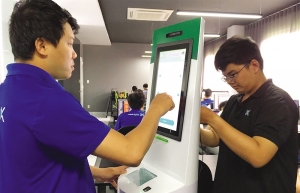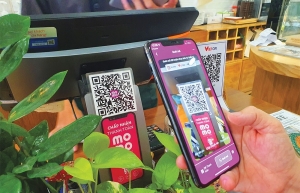Fintech enterprises deploying innovative e-wallet initiatives to capture fair share
More partnerships are being newly formed to reap the benefits of customers increasingly going cashless, from retail users to small- and medium-sized enterprises (SMEs) in Vietnam.
 |
| Fintech enterprises deploying innovative e-wallet initiatives to capture fair share, photo Shutterstock |
In early January, Grab Vietnam and ZaloPay officially entered the cooperation to deploy the new payment method ZaloPay on the Grab app, despite Grab’s existing in-app payment arm Moca.
Alejandro Osorio, CEO of Grab Vietnam, said Southeast Asia’s rapid growth in cashless payments was being spurred by three major patterns, the pandemic, more of the population gaining access to traditional banking services, and the expansion of e-commerce,
Osorio referred to Visa’s Consumer Payment Behaviour report 2022, which found that 83 per cent of Vietnamese intended to switch to cashless payment methods in the near future. According to Osorio, both Grab and ZaloPay will leverage the potential of their large client base.
Nguyen Thi My Hanh, deputy managing director of Grab Vietnam, explained why Grab has GrabPay as an in-app payment service, but also partnered with ZaloPay.
“More customers are opting to use cashless methods on the Grab platform than ever since the pandemic. That’s why we see this opportunity to contribute to the objective of promoting cashless payment in Vietnam. We believe new payment alternatives will enhance the seamless user experience,” Hanh said.
Le Lan Chi, general director of ZaloPay discussed obstacles in persuading customers to adopt new payment methods, particularly those who are resistant to or have little experience with digital platforms, including complex procedures connecting with bank accounts.
“To address this issue, ZaloPay has integrated into the Zalo messaging app, making ZaloPay available to all 100 million users. Fast monetary transactions can be made in-app carried out smoothly. Thanks to that, in 2022, ZaloPay boasted more than 11.5 million payment users with a network of more than 13,000 merchant partners and 35,000 payment points nationwide,” Chi told VIR.
Likewise, Japan’s Sumitomo Mitsui Banking Corporation last year inked an agreement with fintech company SmartNet to purchase $9.2 million worth of shares in the firm.
Founded in 2019, SmartPay by SmartNet has taken a distinct path to promote cashless payment for Vietnamese SMEs.
Marek Forysiak, founder of SmartPay, said, “Unlike other financial institutions, SmartPay puts small merchants at heart. It focuses on providing, developing and designing solutions for SMEs, while other banks and financial institutions target different segments.”
SmartPay’s target customers are small merchants and businesses, and shop owners in Vietnam, whose transactions average from only $1-2. “Therefore, its competitiveness lies in serving the segment at a cost as close to zero as possible,” Forysiak said.
According to data monitoring and analysis system Reputa, Vietnam currently boasts more than 40 e-wallets, with 90 per cent of the market share belonging to MoMo, Moca, and ZaloPay. Next in line are the Shopee AirPay, ViettelPay, and VNPT Pay. These six wallets account for a total of 99 per cent of the market.
A report published by Robocash in December said that over the past four years, the number of e-wallet users has grown from 12.3 million to 41.3 million. By the end of 2022, around 57 per cent of Vietnam’s adult population used e-wallets, as opposed to only 14 per cent at the end of 2018.
Statista noted that in 2022, the value of transitions of digital payments in Vietnam was forecast to reach over $19 billion, the fourth highest in Southeast Asia, surpassing Singapore and Malaysia. Additionally, Vietnam recently beat other developed nations, including the UK, Germany, and the US, in terms of the penetration rate of mobile POS payment, fuelled by the popularity of smartphones across the country.
On the other hand, e-wallet market share is not proportional to profits. MoMo, despite accounting for half of the market share with revenue increasing steadily in 2019-2021, is not profitable. By the end of last year, the company’s accumulated loss amounted to more than $150 million.
Similarly, Zalo Pay also recorded a net loss of up to $50 million in 2021. However, piled-up losses have not cooled the e-wallet market. MoMo even went as far as giving money directly to new customers to occupy market share. Its Lunar New Year campaign, ended on February 10, cost over $4 million but was one of the most recognised advertising campaigns, reaching 40 per cent of consumers.
All the major players are looking to take strategic steps to becoming super apps.
In 2022, MoMo spent heavily to acquire a number of companies, including Tin Viet Securities and cloud-based omnichannel service Quick.vn. VNPay also expanded its ecosystem by teaming up with industry rivals such as 9Pay and VinID to increase the e-payment experience, and is cooperating with Visa in the digital transformation space.
 | Fintech future in store for smarter M&A deals Cross-border merger and acquisition deals are being altered as a direct result of increasing inflation. Nevertheless, foreign investors are exploring untapped potential in the fintech industry to stay competitive in the digital era. |
 | Fintech startups urged to think for long term While tech businesses around the world struggle to raise funds, some fintech companies in Southeast Asia continue to receive large sums. |
What the stars mean:
★ Poor ★ ★ Promising ★★★ Good ★★★★ Very good ★★★★★ Exceptional
Related Contents
Latest News
More News
- From easy money to selective bets: investment prospects for Vietnam in 2026 (January 06, 2026 | 16:51)
- Stock market starts 2026 with growth and governance in focus (January 06, 2026 | 08:45)
- Cake by VPBank posts strong gains in scale and efficiency leveraging AI focus (January 05, 2026 | 18:55)
- Banks step up listing plans in 2026 to strengthen capital and transparency (December 31, 2025 | 18:59)
- Ho Chi Minh City projects $10.5 billion remittance inflows in 2025 (December 31, 2025 | 18:58)
- New decree sharpens enforcement in securities market (December 31, 2025 | 18:53)
- Gold market reform advances as SBV receives applications for bullion production (December 30, 2025 | 12:07)
- EVN and AFD sign credit agreement for Vietnam’s first pumped storage hydropower plant (December 30, 2025 | 10:06)
- Techcombank Priority Visa Signature unlocks a higher standard of living (December 29, 2025 | 16:44)
- Tax sector wraps up 2025 and sets priorities for next year (December 25, 2025 | 14:00)

 Tag:
Tag:



















 Mobile Version
Mobile Version